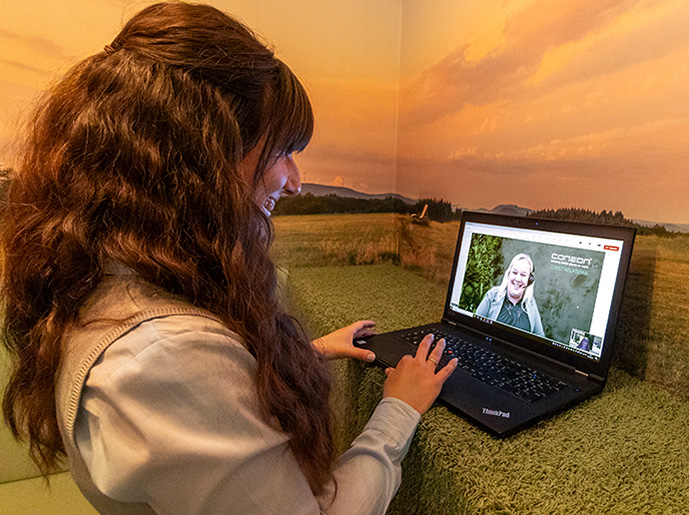Hybrid working
A bridge between home office and office
Working from home continues to be very popular, and the role of the office has changed. The concept of “hybrid working” combines working from home with working on site. However, it is not only the organization within the company that needs to be converted to a hybrid working model; space utilization and room design should also be adapted accordingly.
Contents
1. What does hybrid working mean?
2. How do hybrid working models work?
3. What does hybrid working mean for office design?
4. How can premises and organization be adapted to hybrid working?
5. What are the opportunities and challenges of hybrid working?
6. Home office and hybrid office complement each other

What is hybrid working?
A hybrid working model describes a concept for companies in which employees work both from home or other locations and in the office. The number of days spent in the office and the exact structure of the working model varies depending on the company and employer. The hybrid workplace allows for a great deal of flexibility, but at the same time changes the role of the office.

Hybrid working model – how does it work?
The hybrid working model can vary from company to company. Some companies have a fixed 3-2 rule for full-time employees, whereby employees spend three days in the office and two days working from home. However, hybrid working can also mean complete freedom, with companies tailoring their approach to specific project phases or individual needs. The exact implementation of the “hybrid working” concept often depends on the respective industry and the tasks of the workforce. In any case, clear rules for everyone and transparent communication are prerequisites for successful collaboration.
What does hybrid working mean for office design?
Hybrid working means that not all employees are present on site at the same time. This means that workstations are left empty. If employees in a team work in parallel in the office and from home, the number of desks can be reduced. Saving on unused workstations in turn offers great potential for alternative spaces such as creative zones or collaboration areas. With hybrid working, the office is transforming from the sole place of work to a place of gathering and communication. Project work or inspiring strategy meetings are better held in face-to-face exchanges than via video calls. In addition to areas for communication, a modern office concept based on activity-based working continues to provide quiet areas for phone calls or focused work, as well as traditional workstations.
You can find more information in our Hybrid Workspace Guide.
What could a hybrid office look like?
A hybrid office offers the ideal conditions for hybrid working. A well-designed office concept ensures efficient use of space. Individual desk-sharing concepts are a good way of ensuring that space is used efficiently in hybrid working models. Different zones support different types of tasks in everyday working life. There are quiet areas, as well as open social spaces and interactive rooms that boost inspiration. Flexibility and creative thinking are supported by modular furniture.
Hybrid workplace – technical requirements
Well-functioning technology is a prerequisite for hybrid working. High-quality technical equipment is essential for ensuring smooth networking between employees on site and in their home offices, as well as professional contact with external parties. Suitable rooms for phone calls and video conferences are also essential. Large conference rooms and small meeting rooms with screens are just as much a part of a hybrid office as telephone booths in open-plan areas. Digital whiteboards can also support hybrid working models as a tool.

Adapting premises and internal organization to hybrid working
The introduction of a hybrid working model usually goes hand in hand with a reorganization of internal structures and the creation of hybrid workplaces. Depending on the initial situation, this can require major changes. In many cases, it is worthwhile to work with competent partners to implement the upcoming changes. This allows for an optimal response to individual needs and circumstances and sound planning. Employees should also be involved in the process of transitioning to a hybrid working model.
Opportunities and challenges of hybrid work
The hybrid model combines the advantages of working in the office and remotely. Hybrid working gives employees much greater flexibility. Private appointments and commitments can be easily reconciled with work. The elimination of the commute creates additional freedom on days spent working from home. This can increase satisfaction and, in turn, motivation. Conversely, a motivated workforce and hybrid working models increase the attractiveness of the employer. However, common goals can be pursued more efficiently on site.
Direct exchange is particularly valuable in projects. Informal conversations also lead to valuable ideas that are less likely to arise when working from home. Managing hybrid teams can be challenging for managers. Good organization and transparent communication form the basis when employees are not all gathered in the hybrid office. All employees must feel informed and included, regardless of their location. Corporate culture and collegial cohesion are also less likely to be experienced in the home office. To achieve this, the office must offer the appropriate conditions. An individual office concept that meets the individual needs of employees and the DNA of the company is therefore essential.

Hybrid working model: Working from home and hybrid office complement each other
In hybrid working, the office becomes a place for meeting up. Tasks that require interaction with colleagues are shifted to the office in a hybrid working model, while concentrated individual work can also be done effectively at home. However, working from home cannot offer genuine collegial cohesion and the experience of corporate culture. In order to successfully implement a hybrid office, in addition to internal restructuring and transparent communication, an individual office concept that optimally supports hybrid working is essential.
FAQ
Hybrid working means that employees work both on-site at the office and from home or other locations.
A hybrid office is essential for combining working from home with working on site. It offers flexible workspaces, quiet areas, and creative and collaborative zones. This supports different ways of working and enables efficient use of space.
Hybrid working increases employee flexibility, saves commuting time, and can boost staff satisfaction and motivation. This also makes employers more attractive.
Hybrid working requires reliable tools, video conferencing technology, suitable rooms for phone calls and digital collaboration, and networked work devices.
Leading and organizing hybrid teams can be challenging. Communication and cohesion must be cultivated in a targeted manner. The corporate culture must be designed in such a way that employees feel involved even when working remotely.
Contact us to shape the future of your company together.
Are you planning a new office design or a new working model that requires an analysis of your space, or are you simply looking for ideas for a new office concept?
We would be happy to assist you with your project!


